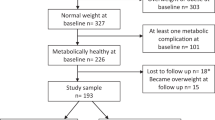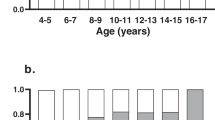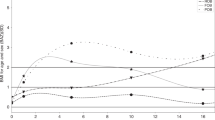Abstract
Objectives
We examined how combinations of clinical indicators at various ages predict overweight/obesity development, as well as resolution, by 10–11 and 14–15 years of age.
Methods
Data were derived from Birth (N = 3469) and Kinder (N = 3276) cohorts of the Longitudinal Study of Australian Children, followed from ages 2–3 and 4–5 years, respectively. Every two years, 25 potential obesity-relevant clinical indicators were quantified. Overweight/obesity was defined using International Obesity Taskforce cutpoints at 10–11 years and 14–15 years.
Results
In both cohorts, three factors predicted both development and resolution of overweight/obesity in multivariable models. Among normal weight children, increased odds of developing overweight/obesity were associated with higher child (odd ratio (OR) 1.67–3.35 across different study waves) and maternal (OR 1.05–1.09) BMI, and inversely with higher maternal education (OR 0.60–0.62, when assessed at age 2–7 years). Lower odds of resolving existing overweight/obesity were related with higher child (OR 0.51–0.79) and maternal (OR 0.89–0.95) BMI, and inversely with higher maternal education (OR 1.62–1.92, when assessed at age 2–5 years). The prevalence of overweight/obesity at the age of 14–15 years was 13% among children with none of these risk factors at age 6–7 years, compared with 71% among those with all 3 risk factors (P < 0.001).
Conclusions
From early childhood onwards, child and maternal BMI and maternal education predict overweight/obesity onset and resolution by adolescence. A simple risk score, easily available to child health clinicians, could help target treatment or prevention.
This is a preview of subscription content, access via your institution
Access options
Subscribe to this journal
Receive 12 print issues and online access
$259.00 per year
only $21.58 per issue
Buy this article
- Purchase on Springer Link
- Instant access to full article PDF
Prices may be subject to local taxes which are calculated during checkout

Similar content being viewed by others
References
Must A, Jacques PF, Dallal GE, Bajema CJ, Dietz WH. Long-term morbidity and mortality of overweight adolescents. A follow-up of the Harvard Growth Study of 1922 to 1935. New Engl J Med. 1992;327:1350–5.
Baker JL, Olsen LW, Sorensen TI. Childhood body-mass index and the risk of coronary heart disease in adulthood. New Engl J Med. 2007;357:2329–37.
Franks PW, Hanson RL, Knowler WC, Sievers ML, Bennett PH, Looker HC. Childhood obesity, other cardiovascular risk factors, and premature death. New Engl J Med. 2010;362:485–93.
Williams EP, Mesidor M, Winters K, Dubbert PM, Wyatt SB. Overweight and obesity: prevalence, consequences, and causes of a growing public health problem. Curr Obes Rep. 2015;4:363–70.
Wake M, Clifford S, Lycett K, Jachno K, Sabin MA, Baldwin S, et al. Natural BMI reductions and overestimation of obesity trial effectiveness. Pediatrics. 2015;135:e292–295.
Juonala M, Magnussen CG, Berenson GS, Venn A, Burns TL, Sabin MA, et al. Childhood adiposity, adult adiposity, and cardiovascular risk factors. New Engl J Med. 2011;365:1876–85.
Brown V, Moodie M, Baur L, Wen LM, Hayes A. The high cost of obesity in Australian pre-schoolers. Aust N Z J Public Health. 2017;41:323–4.
Kerr JA, Long C, Clifford SA, Muller J, Gillespie AN, Donath S, et al. Early-life exposures predicting onset and resolution of childhood overweight or obesity. Arch Dis Child. 2017;102:915–22.
Soloff C, Lawrence D, Johnstone R. Sample design (LSAC technical paper no. 1). Austr Instit Fam Stud. 2005;1:30.
Cole TJ, Bellizzi MC, Flegal KM, Dietz WH. Establishing a standard definition for child overweight and obesity worldwide: international survey. Brit Med J. 2000;320:1240.
National Centre for Education Statistics. National Household Education Surveys Program (NHES). Washington, DC: Department of Education. http://nces.ed.gov/nhes (2006). Accessed 28 March 28 2006.
Sallis JF, Taylor WC, Dowda M, Freeson PS, Pate RR. Correlates of vigorous physical activity for children in grades 1 through 12: Comparing parent-reported and objectively measured physical activity. Pediat Exercise Sci. 2002;14:30–44.
Lycett K, Mensah FK, Hiscock H, Sciberras E. Comparing subjective measures of behavioral sleep problems in children with ADHD: a cross-sectional study. Sleep Med. 2015;16:1377–80.
Gasser CE, Kerr JA, Mensah FK, Wake M. Stability and change in dietary scores and patterns across six waves of the Longitudinal Study of Australian Children. Br J Nutr. 2017;117:1137–50.
DeLong ER, DeLong DM, Clarke-Pearson DL. Comparing the areas under two or more correlated receiver operating characteristic curves: a nonparametric approach. Biometrics. 1988;44:837–45.
Blustein J, Attina T, Liu M, Ryan AM, Cox LM, Blaser MJ, et al. Association of caesarean delivery with child adiposity from age 6 weeks to 15 years. Int J Obes. 2013;37:900–6.
Rios-Castillo I, Cerezo S, Corvalan C, Martinez M, Kain J. Risk factors during the prenatal period and the first year of life associated with overweight in 7-year-old low-income Chilean children. Maternal Child Nutr. 2015;11:595–605.
Robinson SM, Crozier SR, Harvey NC, Barton BD, Law CM, Godfrey KM, et al. Modifiable early-life risk factors for childhood adiposity and overweight: an analysis of their combined impact and potential for prevention. Am J Clin Nutr. 2015;101:368–75.
Loaiza S, Atalah E. Birth weight and obesity risk at first grade of high school in a non-concurrent cohort of Chilean children. Public Health Nutr. 2013;16:228–32.
Sparano S, Ahrens W, De Henauw S, Marild S, Molnar D, Moreno LA, et al. Being macrosomic at birth is an independent predictor of overweight in children: results from the IDEFICS study. Matern Child Health J. 2013;17:1373–81.
Wang L, Mamudu HM, Wu T. The impact of maternal prenatal smoking on the development of childhood overweight in school-aged children. Pediatr Obes. 2013;8:178–88.
Ho SY, Lai YK, Lam TH, Chan V, Mak KK, Lo WS. Risk factors and outcomes of childhood obesity in Hong Kong: a retrospective cohort study. Hong Kong Med. 2013;19:45–7.
Wheaton N, Millar L, Allender S, Nichols M. The stability of weight status through the early to middle childhood years in Australia: a longitudinal study. BMJ Open. 2015;5:e006963.
Jones-Smith J, Dieckmann M, Gottlieb L, Chow J, Fernald LCH. Socioeconomic status and trajectory of obesity from birth to childhood: the early childhood longitudinal study-birth cohort. Am J Epidemol. 2013;177:S153.
Yuan C, Gaskins AJ, Blaine AI, Zhang C, Gillman MW, Missmer SA. et al. Association between cesarean birth and risk of obesity in offspring in childhood, adolescence, and early adulthood. JAMA Pediatr. 2016;170:e162385.
Wang L, Alamian A, Southerland J, Wang K, Anderson J, Stevens M. Cesarean section and the risk of overweight in grade 6 children. Eur J Pediatr. 2013;172:1341–7.
Goldani MZ, Barbieri MA, da Silva AA, Gutierrez MR, Bettiol H, Goldani HA. Cesarean section and increased body mass index in school children: two cohort studies from distinct socioeconomic background areas in Brazil. Nutr J. 2013;12:104.
Juonala M, Juhola J, Magnussen CG, Würtz P, Viikari JS, Thomson R, et al. Childhood environmental and genetic predictors of adulthood obesity: the cardiovascular risk in young Finns study. J Clin Endocrinol Metab. 2011;96:E1542–1549.
Liu T, Lingam R, Lycett K, Mensah FK, Muller J, Hiscock H, et al. Parent-reported prevalence and persistence of 19 common child health conditions. Arch Dis Child. 2018;103:548–56.
Buscot MJ, Thomson RJ, Juonala M, Sabin MA, Burgner DP, Lehtimäki T, et al. BMI Trajectories Associated With Resolution of Elevated Youth BMI and Incident Adult Obesity. Pediatrics. 2018;141:e20172003.
van Rossem L, Wijga AH, Brunekreef B, de Jongste JC, Kerkhof M, Postma DS, et al. Overweight in infancy: which pre- and perinatal factors determine overweight persistence or reduction? A birth cohort followed for 11 years. Ann Nutr Metab. 2014;65:211–9.
Hernandez RG, Marcell AV, Garcia J, Amankwah EK, Cheng TL. Predictors of favorable growth patterns during the obesity epidemic among US school children. Clin Pediatr. 2015;54:458–68.
Ebbeling CB, Pawlak DB, Ludwig DS. Childhood obesity: public-health crisis, common sense cure. The Lancet. 2002;360:473–82.
Laurson KR, Lee JA, Gentile DA, Walsh DA, Eisenmann JC. Concurrent associations between physical activity, screen time, and sleep duration with childhood obesity. ISRN Obes. 2014;2014:204540.
IDEFICS Consortium & Iguacel I, Fernández-Alvira JM, Ahrens W, Bammann K, Gwozdz W, Lissner L. et al. Prospective associations between social vulnerabilities and children’s weight status. Results from the IDEFICS study. Int J Obes. 2018;42:1691–703.
Rolland-Cachera MF, Deheeger M, Bellisle F, Sempe M, Guilloud-Bataille M, Patois E. Adiposity rebound in children: a simple indicator for predicting obesity. Am J Clin Nutr. 1984;39:129–35.
Dietz WH. “Adiposity rebound”: reality or epiphenomenon? Lancet. 2000;356:2027–8.
Gillman MW, Ludwig DS. How early should obesity prevention start? New Engl J Med. 2013;369:2173–5.
Yoshitake N, Okuda M, Sasaki S, Kunitsugu I, Hobara T. Validity of self-reported body mass index of Japanese children and adolescents. Pediatr Int. 2012;54:397–401.
Yong V, Saito Y. How accurate are self-reported height, weight, and BMI among community-dwelling elderly Japanese?: evidence from a national population-based study. Geriatr Gerontol Int. 2012;12:247–56.
Funding
Prof. MJ was supported by Juho Vainio Foundation and federal research grants to Turku University Hospital. Prof. MW was supported by NHMRC Senior Research Fellowship 1046518 and Cure Kids New Zealand. Dr Magnussen is supported by a National Heart Foundation of Australia Future Leader Fellowship (100849). Prof. DB is supported by NHMRC Senior Research Fellowship 1064629 and an Honorary Future Leader Fellowship of the National Heart Foundation of Australia (100369). Dr KL was supported by NHMRC Early Career Fellowship (1091124) and Honorary National Heart Foundation of Australia Postdoctoral Fellowship (101239). Research at the Murdoch Childrens Research Institute research is supported by the Victorian Government’s Operational Infrastructure Program. The funding bodies did not play any role in the study.
Author information
Authors and Affiliations
Corresponding author
Ethics declarations
Conflict of interest
The authors declare that they have no conflict of interest.
Additional information
Publisher’s note Springer Nature remains neutral with regard to jurisdictional claims in published maps and institutional affiliations.
Financial Disclosure: There are no financial relationships relevant to this article to disclose
Supplementary information
Rights and permissions
About this article
Cite this article
Juonala, M., Lau, T., Wake, M. et al. Early clinical markers of overweight/obesity onset and resolution by adolescence. Int J Obes 44, 82–93 (2020). https://doi.org/10.1038/s41366-019-0457-2
Received:
Revised:
Accepted:
Published:
Issue Date:
DOI: https://doi.org/10.1038/s41366-019-0457-2
This article is cited by
-
Can adult polygenic scores improve prediction of body mass index in childhood?
International Journal of Obesity (2022)
-
Looking backwards and forwards: tracking and persistence of weight status between early childhood and adolescence
International Journal of Obesity (2021)



